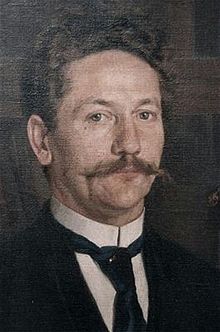Rudolf Jedlička (doctor)
Rudolf Jedlička (born February 20, 1869 in Lysá nad Labem , † October 26, 1926 in Harrachov ) was a Czech doctor, surgeon, radiologist, radiologist and the initiator of a number of social institutions.
Life
Rudolf Jedlička, son of a maternity practitioner, graduated from the medical faculty in Prague in 1892, received his doctorate in 1895, became an assistant at the Maydl surgery clinic in 1898 and a lecturer at the faculty's surgical clinic in 1901.
He achieved world fame as a bone and abdominal surgeon. In his job as a diagnostician at the Prague Surgical Clinic, after the discovery of X-rays in January 1897, he succeeded in performing his operations and diagnoses with this new medium. He also propagated the introduction of this new diagnostic method in Bohemia. For his first investigations he used still imperfect apparatus from the physicists Vincent Strouhal and Domalíp.
When a carpenter devoured a nail one day and was admitted to surgery, it could not be examined on site using the outdated technology. The first X-ray machine in Prague was not in the clinic, but in the Hotel White Horse (Bílý kůň). The hotel owner Cífka bought an X-ray machine as an attraction for his guests, who were able to admire their skeleton in it. Jedlička took his patient to the hotel and took an image in 1.5 hours that showed the unusual location of the nail. This image was then used to carry out the necessary operation and was also the first evidence of the new examination method in Prague.
In March 1898, the clinic purchased its first medical X-ray machine. On November 14, 1898 the first article appeared, a collection of Jedlička's intensive experiences with the new technology under the title O skiagrafii a skiaskopii paprsky roentgenovými a jejich diagnostické ceně v chirurgii .
Jedlička's work and radiographs were exhibited in Paris in 1900 and earned him worldwide recognition. Later he also made a name for himself with the use of x-rays for the treatment of tumors and new surgical techniques ( resection of the stomach ).
In 1901 he qualified as a surgeon on the subject of O subarachnoidálních injekcích . A year later he goes to Germany and buys 20 mg of radio salt with his own funds, which then ends up in the garbage dump due to the inattentiveness of the staff. After the head of the Maydl clinic fell ill, he appointed Jedlička as his successor, albeit against the objection of the dean Spina, who favored the lecturer Kukula. After Maydl's death, there were arguments that were also reported in the press. Eventually, Kukula was appointed head of the clinic.
Jedlička left the trauma clinic and switched to the polyclinic. Here he achieved an improvement in the previously bad situation, but he did not receive the number of beds required for his operations and he took his patients to friends or neighboring hospitals. In 1907 he was appointed associate professor and in 1921 full professor of the Second Surgical Clinic. In 1924 the professorship was expanded to include radiology and radiology.
He solved the unsatisfactory situation in 1909 by building his own sanatorium, which should serve as a model and should also be accessible to the poor. In addition to the surgical station, this sanatorium, completed in 1914, contained an internal department, gynecology, radiology, archive and library.
A year before. In 1913 he founded an institute for physically disabled children in Prague, which was later named after him ( Jedličkův ústav ). The founder's wish was to provide children with professional medical and educational care so that they can lead a full and independent life.
Jedlička died of a heart attack in the Giant Mountains at the age of 57. While still on his deathbed, he married his long-time girlfriend, the nurse Helfertová. He was buried in Prague on the Vyšehrad .
Social medicine merits
His humanitarian and social medicine activities were also significant. In 1905, on his initiative, the Association of Czech Doctors and the Association for Research and Combating Tumors in Bohemia were founded . In the second institution with a biopsy and experimental station, the poor in particular were healed free of charge. He also took part in the doctors' mission in the Balkans, worked in field hospitals and made a name for himself here as well. Out of 71 patients with complicated and infected fractures, he lost only one. In a total of 1788 operations, only 38 patients could no longer be saved.
Jedlička founded orthopedic workshops in which he used his experiences from the Balkan Wars to develop new orthopedic aids and have them built with the help of the disabled.
In 1911 Jedlička was elected chairman of the Association for the Education of the Physically Disabled. He collects money, adds his own and buys a house near Vyšehrad. In 1913 the institute named after him was opened.
literature
- Biography of the Foundation "Nadace Jedličkova ústavu" on www.nadaceju.cz ( Memento from July 16, 2012 in the Internet Archive )
| personal data | |
|---|---|
| SURNAME | Jedlička, Rudolf |
| BRIEF DESCRIPTION | Czech doctor, surgeon, radiologist, radiologist and initiator of a number of social institutions |
| DATE OF BIRTH | February 20, 1869 |
| PLACE OF BIRTH | Lysá nad Labem |
| DATE OF DEATH | October 26, 1926 |
| Place of death | Harrachov |

